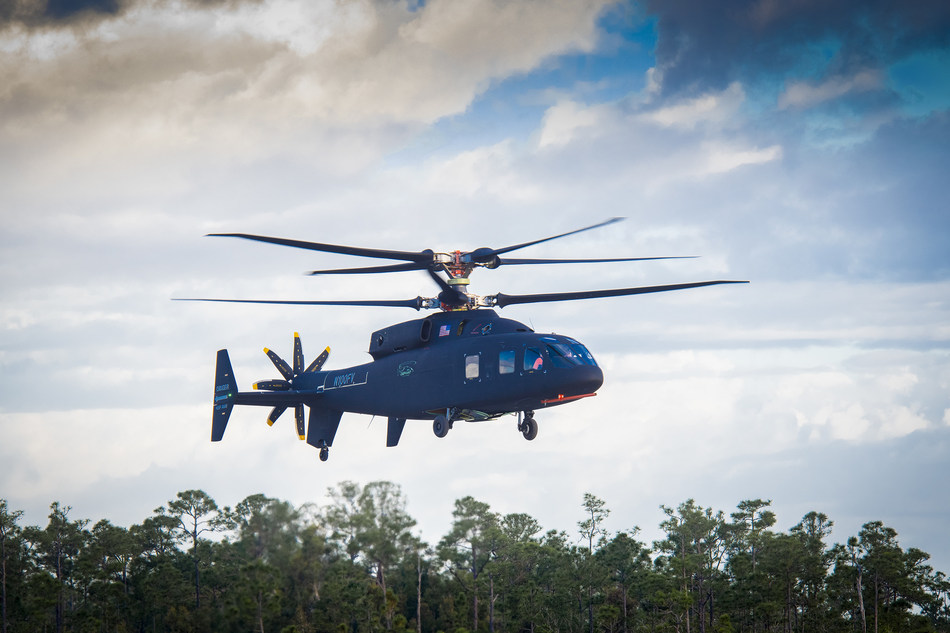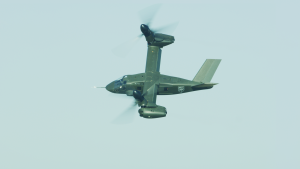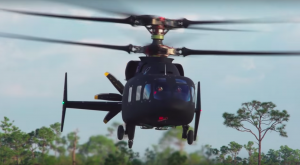4 Flights, 3 Hours, 20 Knots: Boeing’s Defiant Inches Ahead
Posted on

The Sikorsky-Boeing SB>1 Defiant on its first flight, March 21, 2019.
AUSA: The SB>1 Defiant is back in the air, reaching speeds of 20 knots on its fourth test flight. It should reach the Army-mandated minimum speed of 230 knots by the end of March, “if we have no other significant things we learn along the way,” Boeing program manager Ken Eland said here this morning.
He’s referring to a less-than-pleasant surprise earlier this year when the Sikorsky-Boeing team discovered unexpected “bearing creep” in a test gearbox, leading them to ground the actual aircraft for almost two months to make preventive changes.
That was the second major delay for the Defiant after losing multiple months to unexpected difficulties building the large, ultra-rigid rotor blades required – although that hold-up was in part the fault of the Army, which asked the companies to try out some novel manufacturing techniques.

Bell V-280 Valor
But the bottom line is that the Defiant has only made four test flights – three in March and April before the gearbox fix, one after on Sept. 24th – for a total of three hours of flight time – a third of that from the most recent flight.
By contrast, rival Bell Flight’s V-280 Valor tiltrotor first flew in December 2017, 15 months before Defiant. Valor surpassed 100 flight hours and 300 knots airspeed in April, just as Defiant was making its first flights. Bell is now doing extra-credit testing like flying the Valor in unmanned mode.
All that extra flight data, and the field-testing performance it describes, gives Bell’s Valor an advantage in the competition to replace the Army UH-60 Black Hawk — and potentially Marine and Special Operations transport aircraft as well. But the Sikorsky-Boeing team can still complete their test program, prove Defiant can meet the Army’s requirements, and get the data to the military in time to affect its decision.

SB>1 Defiant, front view
That’s because both Valor and Defiant are demonstrator aircraft, part of the Joint Multi-Role (JMR) program to explore the art of the possible, and are not final designs for the Army’s Future Long-Range Assault Aircraft (FLRAA). Both companies turned in their white paper preliminary proposals for FLRAA by the Oct. 1 deadline, but they will have 18 months after that to make refinements and discuss trade-offs with the Army. The final designs aren’t due until fall 2021, and the Army won’t actually decide which aircraft to build until roughly March 2022.
(A technicality: In February next year, Army will award the contracts to develop final designs. But it’ll award two of those contracts, and given that Bell and Sikorsky-Boeing are the only contenders with actual demonstrator aircraft, it’s a safe assumption both will get an award).

The Sikorsky Raider-X, Lockheed Martin’s proposed design for the Army’s Future Attack Reconnaissance Aircraft
While the Sikorsky-Boeing team’s final FLRAA proposal will not be identical to the Defiant – it’ll probably be somewhat larger to meet all the Army’s requirements — it’ll be very similar, Eland and other executives said.
Meanwhile, Sikorsky can take comfort in their strong position on the Army’s other Future Vertical Lift competition, the Future Attack Reconnaissance Aircraft. (While Boeing is teamed with Sikorsky on FLRAA, they’re competitors on FARA).
So far, Sikorsky’s is the only entry derived from a real aircraft with lots of test flights under its belt. That’s the S-97 Raider, which first flew in 2015, and whose design Sikorsky has now scaled up by 27 percent into its final FARA proposal, the Raider-X. By contrast, Bell is offering the Bell 360 Invictus, which shares its fly-by-wire system with the commercial Bell 525 but is otherwise an all-new design. So on the FARA contract, it’s Sikorsky that’s ahead and Bell that has a lot of prove.
Subscribe to our newsletter
Promotions, new products and sales. Directly to your inbox.
